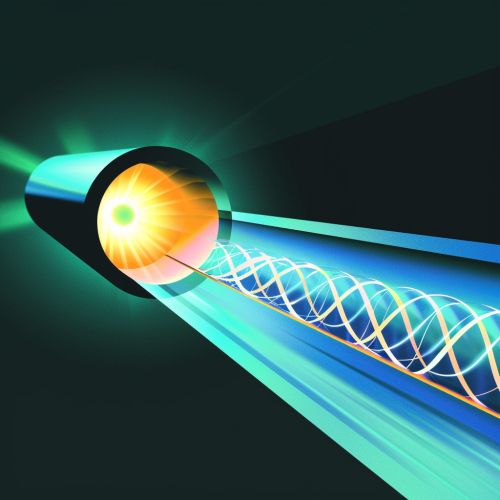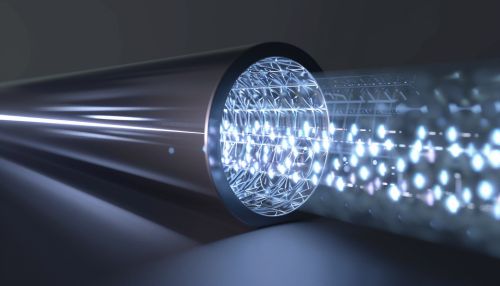Quantum Tunnelling: Difference between revisions
(Created page with "== Introduction == Quantum tunnelling is a quantum mechanical phenomenon where particles move through a barrier that they classically should not be able to pass. This effect is a direct consequence of the wave-like properties of particles and the probabilistic nature of quantum mechanics. Quantum tunnelling is a fundamental concept in quantum mechanics and has significant implications in various fields such as nuclear physics, semiconductor physics, and chemistry....") |
No edit summary |
||
| Line 99: | Line 99: | ||
* [[Enzyme catalysis]] | * [[Enzyme catalysis]] | ||
[[Image:Detail-91725.jpg|thumb|center|Illustration of a particle tunnelling through a potential barrier. The image should show a wave function approaching, decaying within, and re-emerging from the barrier.|class=only_on_mobile]] | |||
[[Image:Detail-91726.jpg|thumb|center|Illustration of a particle tunnelling through a potential barrier. The image should show a wave function approaching, decaying within, and re-emerging from the barrier.|class=only_on_desktop]] | |||
== References == | == References == | ||
Latest revision as of 22:41, 19 June 2024
Introduction
Quantum tunnelling is a quantum mechanical phenomenon where particles move through a barrier that they classically should not be able to pass. This effect is a direct consequence of the wave-like properties of particles and the probabilistic nature of quantum mechanics. Quantum tunnelling is a fundamental concept in quantum mechanics and has significant implications in various fields such as nuclear physics, semiconductor physics, and chemistry.
Historical Background
The concept of quantum tunnelling was first introduced in the early 20th century. In 1928, George Gamow, Ronald Gurney, and Edward Condon independently developed the theory to explain alpha decay in radioactive nuclei. They showed that alpha particles could escape a nucleus by tunnelling through the potential barrier, a process that classical physics could not explain.
Quantum Mechanics Foundation
Wave-Particle Duality
Quantum tunnelling arises from the wave-particle duality of matter. According to quantum mechanics, particles such as electrons and protons exhibit both particle-like and wave-like properties. The wave function describes the probability amplitude of finding a particle in a particular location. When a particle encounters a potential barrier, its wave function does not abruptly drop to zero but instead decays exponentially within the barrier.
Schrödinger Equation
The behavior of particles in quantum mechanics is governed by the Schrödinger equation. For a particle of mass \( m \) encountering a one-dimensional potential barrier \( V(x) \), the time-independent Schrödinger equation is given by:
\[ -\frac{\hbar^2}{2m} \frac{d^2 \psi(x)}{dx^2} + V(x) \psi(x) = E \psi(x) \]
where \( \hbar \) is the reduced Planck's constant, \( \psi(x) \) is the wave function, and \( E \) is the energy of the particle. When \( E < V(x) \), the solution to the Schrödinger equation within the barrier is an exponentially decaying function, indicating a non-zero probability of finding the particle within the barrier.
Mathematical Description
Potential Barrier
Consider a particle encountering a rectangular potential barrier of height \( V_0 \) and width \( a \). The potential \( V(x) \) is defined as:
\[ V(x) = \begin{cases} 0 & \text{for } x < 0 \\ V_0 & \text{for } 0 \leq x \leq a \\ 0 & \text{for } x > a \end{cases} \]
The wave function \( \psi(x) \) can be divided into three regions: before the barrier, within the barrier, and after the barrier.
Transmission and Reflection Coefficients
The probability of a particle tunnelling through the barrier is quantified by the transmission coefficient \( T \). For a rectangular barrier, \( T \) is given by:
\[ T = \frac{1}{1 + \frac{V_0^2 \sinh^2(\kappa a)}{4E(V_0 - E)}} \]
where \( \kappa = \sqrt{\frac{2m(V_0 - E)}{\hbar^2}} \). The reflection coefficient \( R \) is related to \( T \) by \( R = 1 - T \).
Applications
Nuclear Physics
Quantum tunnelling plays a crucial role in nuclear physics, particularly in the process of alpha decay. In alpha decay, an alpha particle (comprising two protons and two neutrons) tunnels out of the nucleus through the nuclear potential barrier. This process explains the observed decay rates of radioactive nuclei.
Semiconductor Devices
In semiconductor physics, quantum tunnelling is essential for the operation of devices such as the tunnel diode and the quantum dot. Tunnel diodes exploit the tunnelling effect to achieve negative resistance, which is useful in high-speed and microwave applications. Quantum dots, on the other hand, rely on tunnelling to confine electrons in small regions, leading to discrete energy levels.
Chemical Reactions
Quantum tunnelling also affects chemical reactions, particularly those involving light atoms such as hydrogen. The phenomenon allows particles to overcome activation energy barriers, leading to reaction rates that are higher than those predicted by classical transition state theory.
Experimental Observations
Scanning Tunnelling Microscopy
One of the most significant experimental applications of quantum tunnelling is in scanning tunnelling microscopy (STM). STM uses the tunnelling current between a sharp metallic tip and a conductive surface to image surfaces at the atomic level. The tunnelling current is highly sensitive to the distance between the tip and the surface, allowing for atomic-scale resolution.
Josephson Junctions
Another important application is in Josephson junctions, which consist of two superconductors separated by a thin insulating barrier. Cooper pairs of electrons can tunnel through the barrier, leading to the Josephson effect. This phenomenon is the basis for superconducting quantum interference devices (SQUIDs), which are used in highly sensitive magnetometers.
Theoretical Implications
Quantum Field Theory
Quantum tunnelling has profound implications in quantum field theory (QFT). In QFT, tunnelling events are described by instantons, which are solutions to the equations of motion in imaginary time. Instantons play a crucial role in understanding non-perturbative effects and vacuum decay in quantum fields.
Cosmology
In cosmology, quantum tunnelling is hypothesized to be involved in processes such as inflation and the formation of the early universe. The concept of tunnelling through a potential barrier is used to explain the transition from a false vacuum to a true vacuum, leading to the rapid expansion of the universe.
Advanced Topics
Tunnelling in Complex Potentials
While the basic theory of quantum tunnelling deals with simple potential barriers, real-world scenarios often involve complex potentials. These potentials can include multiple barriers, varying barrier heights, and non-uniform widths. Advanced mathematical techniques, such as the WKB approximation and numerical methods, are employed to study tunnelling in these complex systems.
Quantum Tunnelling in Biological Systems
Recent research has explored the role of quantum tunnelling in biological systems. For example, tunnelling is thought to play a role in the process of photosynthesis, where electrons transfer through protein complexes. Additionally, it has been suggested that quantum effects, including tunnelling, may be involved in the mechanisms of enzyme catalysis.
See Also
- Alpha decay
- Tunnel diode
- Quantum dot
- Scanning tunnelling microscopy
- Josephson junction
- Quantum field theory
- Inflation (cosmology)
- Photosynthesis
- Enzyme catalysis


